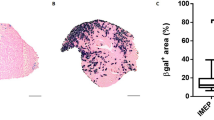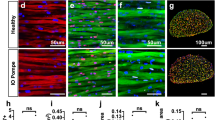Abstract
Electrotransfer of plasmid DNA in skeletal muscle is a common non-viral delivery method for both therapeutic genes and DNA vaccines. Yet, despite the similar approaches, an immune response is detrimental in gene therapy, but desirable for vaccines. However, the full nature of the immune and tissue responses to nucleic acids and electrotransfer in skeletal muscle has not been addressed. Here we used microarray analysis, fluorescence-activated cell sorting and quantitative polymerase chain reaction to obtain the molecular and cellular signature of the tissue and immune response to electrotransfer of saline and non-coding plasmid DNA. Saline electrotransfer resulted in limited infiltration and induction of a moderate damage–repair gene expression pattern not involving innate immune activation. However, plasmid electrotransfer augmented expression of the same genes in addition to inducing a strong innate immune response associated with pro-inflammatory infiltration. In particular, the inflammasome, Toll-like receptor 9 and other pattern recognition receptors able to respond to cytoplasmic DNA were upregulated. Several key differences in the nature of the inflammatory infiltrate and the kinetics of gene expression were also identified when comparing electrotransfer of conventional and CpG-free plasmids. Our data provide insights into the mechanisms of DNA detection and response in muscle that has relevance for non-viral gene therapy and DNA vaccination.
This is a preview of subscription content, access via your institution
Access options
Subscribe to this journal
Receive 12 print issues and online access
$259.00 per year
only $21.58 per issue
Buy this article
- Purchase on Springer Link
- Instant access to full article PDF
Prices may be subject to local taxes which are calculated during checkout






Similar content being viewed by others
References
Wolff JA, Budker V . The mechanism of naked DNA uptake and expression. Adv Genet 2005; 54: 3–20.
Mir LM . Nucleic acids electrotransfer-based gene therapy (electrogenetherapy): past, current, and future. Mol Biotechnol 2009; 43: 167–176.
Lu QL, Bou-Gharios G, Partridge TA . Non-viral gene delivery in skeletal muscle: a protein factory. Gene Therapy 2003; 10: 131–142.
Braun S . Muscular gene transfer using nonviral vectors. Curr Gene Ther 2008; 8: 391–405.
Babiuk S, van Drunen Littel-van den H, Babiuk LA . Delivery of DNA vaccines using electroporation. Methods Mol Med 2006; 127: 73–82.
Luckay A, Sidhu MK, Kjeken R, Megati S, Chong SY, Roopchand V et al. Effect of plasmid DNA vaccine design and in vivo electroporation on the resulting vaccine-specific immune responses in rhesus macaques. J Virol 2007; 81: 5257–5269.
Mingozzi F, High KA . Immune responses to AAV in clinical trials. Curr Gene Ther 2007; 7: 316–324.
Marino M, Scuderi F, Provenzano C, Bartoccioni E . Skeletal muscle cells: from local inflammatory response to active immunity. Gene Therapy 2011; 18: 109–116.
Krieg AM . CpG motifs in bacterial DNA and their immune effects. Annu Rev Immunol 2002; 20: 709–760.
Wagner H . The immunobiology of the TLR9 subfamily. Trends Immunol 2004; 25: 381–386.
Meylan E, Tschopp J, Karin M . Intracellular pattern recognition receptors in the host response. Nature 2006; 442: 39–44.
Hornung V, Latz E . Intracellular DNA recognition. Nat Rev Immunol 2010; 10: 123–130.
Martinon F, Mayor A, Tschopp J . The inflammasomes: guardians of the body. Annu Rev Immunol 2009; 27: 229–265.
Kawai T, Akira S . The role of pattern-recognition receptors in innate immunity: update on Toll-like receptors. Nat Immunol 2011; 11: 373–384.
Boyle EI, Weng S, Gollub J, Jin H, Botstein D, Cherry JM et al. GO::TermFinder—open source software for accessing Gene Ontology information and finding significantly enriched Gene Ontology terms associated with a list of genes. Bioinformatics 2004; 20: 3710–3715.
Nicolas N, Marazzi G, Kelley K, Sassoon D . Embryonic deregulation of muscle stress signaling pathways leads to altered postnatal stem cell behavior and a failure in postnatal muscle growth. Dev Biol 2005; 281: 171–183.
Krief S, Faivre JF, Robert P, Le Douarin B, Brument-Larignon N, Lefrere I et al. Identification and characterization of cvHsp. A novel human small stress protein selectively expressed in cardiovascular and insulin-sensitive tissues. J Biol Chem 1999; 274: 36592–36600.
Liu Y, Wang J, Yi Y, Zhang H, Liu J, Liu M et al. Induction of KLF4 in response to heat stress. Cell Stress Chaperones 2006; 11: 379–389.
Wiendl H, Hohlfeld R, Kieseier BC . Immunobiology of muscle: advances in understanding an immunological microenvironment. Trends Immunol 2005; 26: 373–380.
Bekpen C, Hunn JP, Rohde C, Parvanova I, Guethlein L, Dunn DM et al. The interferon-inducible p47 (IRG) GTPases in vertebrates: loss of the cell autonomous resistance mechanism in the human lineage. Genome Biol 2005; 6: R92.
Takaoka A, Wang Z, Choi MK, Yanai H, Negishi H, Ban T et al. DAI (DLM-1/ZBP1) is a cytosolic DNA sensor and an activator of innate immune response. Nature 2007; 448: 501–505.
Yanai H, Ban T, Wang Z, Choi MK, Kawamura T, Negishi H et al. HMGB proteins function as universal sentinels for nucleic-acid-mediated innate immune responses. Nature 2009; 462: 99–103.
Kim T, Pazhoor S, Bao M, Zhang Z, Hanabuchi S, Facchinetti V et al. Aspartate–glutamate–alanine–histidine box motif (DEAH)/RNA helicase A helicases sense microbial DNA in human plasmacytoid dendritic cells. Proc Natl Acad Sci USA 2010; 107: 15181–15186.
Unterholzner L, Keating SE, Baran M, Horan KA, Jensen SB, Sharma S et al. IFI16 is an innate immune sensor for intracellular DNA. Nat Immunol 2010; 11: 997–1004.
Stetson DB, Ko JS, Heidmann T, Medzhitov R . Trex1 prevents cell-intrinsic initiation of autoimmunity. Cell 2008; 134: 587–598.
Chiu YH, Macmillan JB, Chen ZJ . RNA polymerase III detects cytosolic DNA and induces type I interferons through the RIG-I pathway. Cell 2009; 138: 576–591.
Ablasser A, Bauernfeind F, Hartmann G, Latz E, Fitzgerald KA, Hornung V . RIG-I-dependent sensing of poly(dA:dT) through the induction of an RNA polymerase III-transcribed RNA intermediate. Nat Immunol 2009; 10: 1065–1072.
Kim YM, Brinkmann MM, Paquet ME, Ploegh HL . UNC93B1 delivers nucleotide-sensing toll-like receptors to endolysosomes. Nature 2008; 452: 234–238.
Ishii KJ, Kawagoe T, Koyama S, Matsui K, Kumar H, Kawai T et al. TANK-binding kinase-1 delineates innate and adaptive immune responses to DNA vaccines. Nature 2008; 451: 725–729.
Sadler AJ, Williams BR . Interferon-inducible antiviral effectors. Nat Rev Immunol 2008; 8: 559–568.
Shirota H, Petrenko L, Hong C, Klinman DM . Potential of transfected muscle cells to contribute to DNA vaccine immunogenicity. J Immunol 2007; 179: 329–336.
Ishii KJ, Coban C, Kato H, Takahashi K, Torii Y, Takeshita F et al. A Toll-like receptor-independent antiviral response induced by double-stranded B-form DNA. Nat Immunol 2006; 7: 40–48.
Stetson DB, Medzhitov R . Recognition of cytosolic DNA activates an IRF3-dependent innate immune response. Immunity 2006; 24: 93–103.
Arnold L, Henry A, Poron F, Baba-Amer Y, van Rooijen N, Plonquet A et al. Inflammatory monocytes recruited after skeletal muscle injury switch into antiinflammatory macrophages to support myogenesis. J Exp Med 2007; 204: 1057–1069.
Orange JS, Ballas ZK . Natural killer cells in human health and disease. Clin Immunol 2006; 118: 1–10.
Tamura T, Yanai H, Savitsky D, Taniguchi T . The IRF family transcription factors in immunity and oncogenesis. Annu Rev Immunol 2008; 26: 535–584.
Hojman P, Zibert JR, Gissel H, Eriksen J, Gehl J . Gene expression profiles in skeletal muscle after gene electrotransfer. BMC Mol Biol 2007; 8: 56.
Rubenstrunk A, Mahfoudi A, Scherman D . Delivery of electric pulses for DNA electrotransfer to mouse muscle does not induce the expression of stress related genes. Cell Biol Toxicol 2004; 20: 25–31.
Hojman P, Gissel H, Andre F, Cournil-Henrionnet C, Eriksen J, Gehl J et al. Physiological effects of high and low voltage pulse combinations for gene electrotransfer in muscle. Hum Gene Ther 2008; 19: 1249–1260.
Dupuis M, Denis-Mize K, Woo C, Goldbeck C, Selby MJ, Chen M et al. Distribution of DNA vaccines determines their immunogenicity after intramuscular injection in mice. J Immunol 2000; 165: 2850–2858.
Kutzler MA, Weiner DB . DNA vaccines: ready for prime time? Nat Rev Genet 2008; 9: 776–788.
Eisenbarth SC, Colegio OR, O’Connor W, Sutterwala FS, Flavell RA . Crucial role for the Nalp3 inflammasome in the immunostimulatory properties of aluminium adjuvants. Nature 2008; 453: 1122–1126.
McCaffrey AP, Fawcett P, Nakai H, McCaffrey RL, Ehrhardt A, Pham TT et al. The host response to adenovirus, helper-dependent adenovirus, and adeno-associated virus in mouse liver. Mol Ther 2008; 16: 931–941.
Hartman ZC, Black EP, Amalfitano A . Adenoviral infection induces a multi-faceted innate cellular immune response that is mediated by the toll-like receptor pathway in A549 cells. Virology 2007; 358: 357–372.
Hartman ZC, Appledorn DM, Amalfitano A . Adenovirus vector induced innate immune responses: impact upon efficacy and toxicity in gene therapy and vaccine applications. Virus Res 2008; 132: 1–14.
Babiuk S, Mookherjee N, Pontarollo R, Griebel P, van Drunen Littel-van den Hurk S, Hecker R et al. TLR9−/− and TLR9+/+ mice display similar immune responses to a DNA vaccine. Immunology 2004; 113: 114–120.
Eisen MB, Spellman PT, Brown PO, Botstein D . Cluster analysis and display of genome-wide expression patterns. Proc Natl Acad Sci USA 1998; 95: 14863–14868.
Pfaffl MW . A new mathematical model for relative quantification in real-time RT-PCR. Nucleic Acids Res 2001; 29: e45.
Acknowledgements
We thank Vera Lukesova for additional histological assistance, Yacine Kharraz for generous help with FACS experiments and Vanesa Ruiz for technical assistance. CJM was recipient of a post-doctoral fellowship from Ministerio de Educación, Cultura y Deporte, Spain. This work was supported by grants from the Ministerio de Ciencia e Innovación, Plan Nacional I+D+I (SAF2005-01262 and SAF2008-00962), Spain and European Community (CLINIGENE, LSHB-CT-2006-018933).
Author information
Authors and Affiliations
Corresponding author
Ethics declarations
Competing interests
The authors declare no conflict of interest.
Additional information
Supplementary Information accompanies the paper on Gene Therapy website
Supplementary information
Rights and permissions
About this article
Cite this article
Mann, C., Anguela, X., Montané, J. et al. Molecular signature of the immune and tissue response to non-coding plasmid DNA in skeletal muscle after electrotransfer. Gene Ther 19, 1177–1186 (2012). https://doi.org/10.1038/gt.2011.198
Received:
Revised:
Accepted:
Published:
Issue Date:
DOI: https://doi.org/10.1038/gt.2011.198
Keywords
This article is cited by
-
Plasmid-mediated gene transfer of Cas9 induces vector-related but not SpCas9-related immune responses in human retinal pigment epithelial cells
Scientific Reports (2022)
-
Safe and efficient novel approach for non-invasive gene electrotransfer to skin
Scientific Reports (2018)
-
APOBEC3A intratumoral DNA electroporation in mice
Gene Therapy (2017)
-
Cytosolic DNA Sensor Upregulation Accompanies DNA Electrotransfer in B16.F10 Melanoma Cells
Molecular Therapy - Nucleic Acids (2016)
-
APOBEC3A catabolism of electroporated plasmid DNA in mouse muscle
Gene Therapy (2015)



